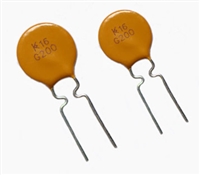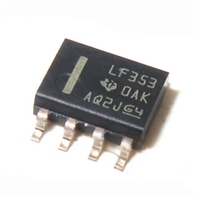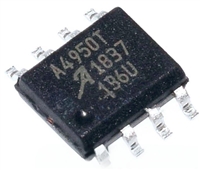MA2901
This multiplexer scheme gives the capability of selecting
various pairs of the A, B, D, Q and “0” inputs as source
operands to the ALU. These five inputs, when taken two at a
time, result in ten possible combinations of source operand
pairs. These combinations include AB, AD, AQ, A0, BD, BQ,
B0, DQ, D0 and Q0. It is apparent the AD, AQ and A0 are
somewhat redundant with BD, BQ and B0 in that if the A
address and B address are the same, the identical function
results. Thus, there are only seven completely non-redundant
sourced operand pairs for the ALU. The MA2901
microprocessor implements eight of these pairs. The
microinstruction inputs used to select the ALU source
operands are the l0, I1, and I2 inputs. The definition of l0, I1, and
I2 for the eight source operand combinations are as shown in
figure 2. Also shown is the octal code for each selection.
The two source operands not fully described as yet are the
D input and Q input. The D input is the four-bit wide direct data
field input. This port is used to insert all data into the working
registers inside the device. Likewise this input can be used in
the ALU to modify any of the internal data files. The Q register
is a separate 4-bit file intended primarily for multiplication and
division routines but it can also be used as an accumulator or
holding register for some applications.
The ALU itself is a high speed arithmetic/logic operator
capable of performing three binary arithmetic and five logic
functions. The I3, I4, and I5 microinstruction inputs are used to
select the ALU function. The definition of these inputs is shown
in Figure 3. The octal code is also shown for reference. The
normal technique for cascading ALU of several devices is in a
look-ahead carry mode. Carry generate, GN, and carry
propagate, PN, are outputs of the device for use with a carry-
look-ahead-generator. A carry-out Cn + 4, is also generated
and is available as an output for use as the carry flag in a
status register. Both carry-in (Cn) and carry-out (Cn+4) are
active HIGH.
The ALU has three other status-oriented outputs. These
are F3, F=0, and overflow (OVR). The F3 output is the most
significant (sign) bit of the ALU and can be used to determine
positive or negative results without enabling the three-state
data outputs. F3 is non-inverted with respect to the sign bit
output Y3. The F = 0 output is used for zero detect. It is an
open-collector output and can be wire OR’ed between
microprocessor slices. F = 0 is HIGH when all F outputs are
LOW. The overflow output (OVR) is used to flag arithmetic
operations that exceed the available two’s complement
number range. The overflow output (OVR) is HIGH when
overflow exists. That is when Cn + 3 and Cn + 4 are not the
same polarity.
The ALU data output is routed to several destinations. It
can be a data output of the device and it can also be stored in
the RAM or the Q register. Eight possible combinations of ALU
destination functions are available as defined by the I6, I7, and
I8 microinstruction inputs. These combinations are shown in
figure 4.
The four-bit data output field (Y) features three-state
outputs and can be directly bus organised. An output control
(OEN) is used to enable the three-state outputs. When OEN is
HIGH, the Y outputs are in the high impedance state.
A two-input multiplexer is also used at the data output
such that either the A-port of the RAM or the ALU outputs (F)
are selected at the device Y outputs. This selection is
controlled by the I6, I7, and I8 microinstruction inputs.
As was discussed previously, the RAM inputs are driven
from a three-input multiplexer. This allows the ALU outputs to
be entered non-shifted, shifted up one position (x 2) or shifted
down one position (÷ 2). The shifter has two ports; labeled
RAM0 and RAM3. Both of these ports consist of a buffer-driver
with a three-state output and an input to the multiplexer.
Microcode
ALU Source
Operands
Microcode
ALU
Symbol
Function
Octal
Code
I
I
I
0
Octal
Code
I
I
I
3
2
1
5
4
R
S
R + S
R plus S
L
L
L
0
1
2
3
4
5
6
7
L
L
L
0
1
2
3
4
5
6
7
A
A
0
C
B
Q
B
A
A
Q
0
S - R
S minus R
R minus S
R OR S
H
L
L
L
L
L
H
L
R - S
L
H
H
L
L
H
H
L
R ÚS
H
L
L
L
H
L
0
RN Ù S
R Ù S
R Ñ S
RN Ñ SN
RN AND S
R AND S
H
H
H
H
H
H
H
H
0
H
L
L
H
L
D
D
D
L
H
H
R EX-OR S
R EX-NOR S
H
H
H
H
+ = plus; - = minus; = OR; L = AND; Ñ = EX-OR
V
Figure 2: ALU Source Operand Control
Figure 2: ALU Function Control
3






 NTC热敏电阻与PTC热敏电阻的应用原理及应用范围
NTC热敏电阻与PTC热敏电阻的应用原理及应用范围

 GTO与普通晶闸管相比为什么可以自关断?为什么普通晶闸管不能呢?从GTO原理、应用范围带你了解原因及推荐型号
GTO与普通晶闸管相比为什么可以自关断?为什么普通晶闸管不能呢?从GTO原理、应用范围带你了解原因及推荐型号

 LF353数据手册解读:特性、应用、封装、引脚说明、电气参数及替换型号推荐
LF353数据手册解读:特性、应用、封装、引脚说明、电气参数及替换型号推荐

 A4950资料手册解读:特性、应用、封装、引脚功能、电气参数及代换型号
A4950资料手册解读:特性、应用、封装、引脚功能、电气参数及代换型号
